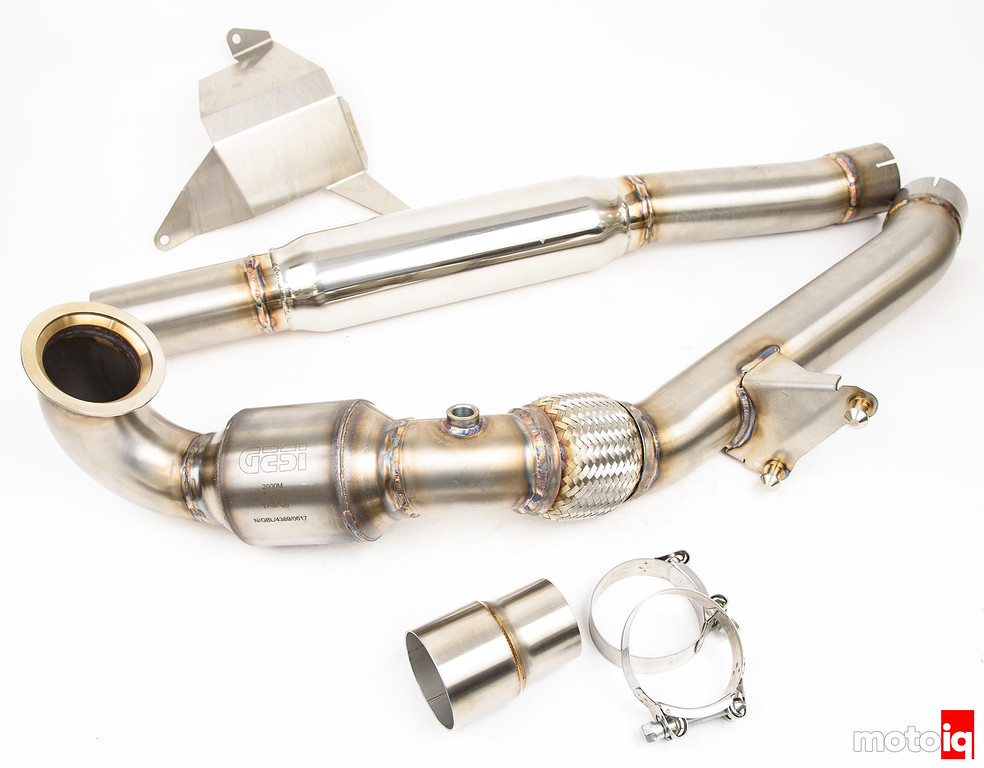
The factory downpipe is a beefy cast unit that meets exhaust exiting out of the turbine housing with an immediate 45* direction change before being directed into the restrictive factory catalyst. The COBB mandrel bent radius will improve flow out of the turbine housing and into the high flow GESI catalyst.

Howard begins the factory downpipe removal by disconnecting and removing the oxygen sensor to protect it from damage. After removing the oxygen sensor, Howard removed the v-band clamp and a few bolts that were accessible from the top.

In order to slide the downpipe out the bottom of the chassis, unbolting the drive shaft is necessary. This step gives you a lot more room that you will need to slide the huge factory catalyst down between the back of the motor and the firewall.

With the factory downpipe out of the car, you can see the harsh bend that gasses exiting the turbine have to contend with before entering the restrictive factory catalyst. The gasses exit the factory catalyst via another section of pipe with harsh angles and flow restrictions.

Howard easily slides the COBB downpipe into place thanks to the much slimmer profile of the GESI catalyst. The factory lower NVH isolating mounting bracket is moved over from the factory downpipe and helps line up the downpipe for installation of the resonated 3″ mid pipe section.




8 comments
I would suggest painting your intercooler black for better effectiveness.
I did think about doing that, but the intercooler was just too pretty. Also, the emicivity gains from the black paint job sort loose effectiveness once you start to have air flowing across the heat exchanger.
how much more boost does the stage 3 tune tune? very surprised you only picked up 15 peak hp and 30lb ft with a hotter tune and big downpipe/intercooler. I suspect that if you get the TCU tuned, the numbers will jump up to where they ought to be. Also, any concern not having apples/apples because you changed the load parameters on the dyno between runs?
Can anyone explain a couple of things?
The MK7 Golf R is rated at 292hp at the crank from the factory. Generally speaking a AWD system will loose around 20% of power thru the drivetrain but….
1. This Golf doesn’t have the Haldex system hooked up on the dyno?!
2. If the 20% loss in power is a realistic number; that means that without the COBB downpipe/ APR IC and the COBB tune this Golf would only make around 210whp?
If 210whp is a realistic number, that means that this Golf R (or any stock Golf R for that matter) have a drivetrain loose of about 29%?
That is a HUGE % loss in the drivetrain considering this car is fairly new.
As Billy pointed out above, I believe we will see even more power when we update the TCU. Also, the motoiq in house dyno does read low. I’m not a dyno expert, so I’m not exactly sure what difference the change to the dyno made to the power readings.
Our dyno does read low, the power numbers don’t matter, they change from dyno to dyno, what matters is the difference in power when comparing to stock or prior mods.
Thanks Isaac. I understand that the TCU has to be updated but my concern was about the fact this bone stock MK7 Golf R has a drivetrain loss of roughly 29%…..
As Mike said, dyno numbers are not very important as each dyno read differently and temp/ humidity and other factors play an important role of how the ECU response…..but I’m still baffled a can this new can loose that much.
I wish Cobb would release an option for S3 owners. I’ve been holding out, hoping they come around, but if they don’t I’ll likely get something from 034 Motorsports.